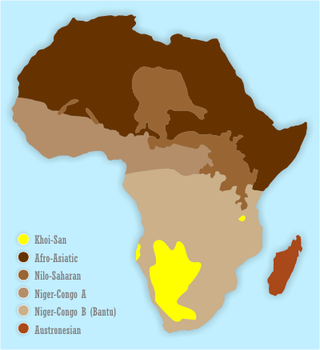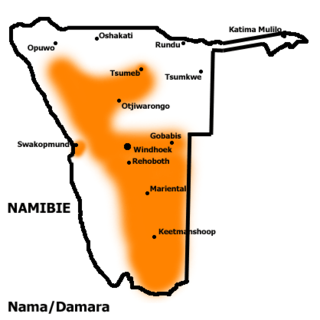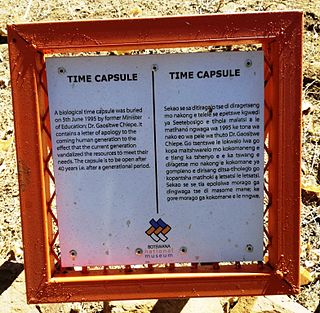Click consonants, or clicks, are speech sounds that occur as consonants in many languages of Southern Africa and in three languages of East Africa. Examples familiar to English-speakers are the tut-tut or tsk! tsk! used to express disapproval or pity, the tchick! used to spur on a horse, and the clip-clop! sound children make with their tongue to imitate a horse trotting. However, these paralinguistic sounds in English are not full click consonants, as they only involve the front of the tongue, without the release of the back of the tongue that is required for clicks to combine with vowels and form syllables.

The Khoisan languages are a number of African languages once classified together, originally by Joseph Greenberg. Khoisan is defined as those languages that have click consonants and do not belong to other African language families. For much of the 20th century, they were thought to be genealogically related to each other, but this is no longer accepted. They are now held to comprise three distinct language families and two language isolates.

Taa, also known as ǃXóõ, is a Tuu language notable for its large number of phonemes, perhaps the largest in the world. It is also notable for having perhaps the heaviest functional load of click consonants, with one count finding that 82% of basic vocabulary items started with a click. Most speakers live in Botswana, but a few hundred live in Namibia. The people call themselves ǃXoon or ʼNǀohan, depending on the dialect they speak. The Tuu languages are one of the three traditional language families that make up the Khoisan languages. In 2011, there were around 2,500 speakers of Taa.

Khoekhoe, also known by the ethnic terms Nama, Damara (ǂNūkhoegowab), or Nama/Damara and formerly as Hottentot, is the most widespread of the non-Bantu languages of Southern Africa that make heavy use of click consonants and therefore were formerly classified as Khoisan, a grouping now recognized as obsolete. It belongs to the Khoe language family, and is spoken in Namibia, Botswana, and South Africa primarily by three ethnic groups: Namakhoen, ǂNūkhoen, and Haiǁomkhoen.
ǂʼAmkoeAM-koy, formerly called by the dialectal name ǂHoan, is a severely endangered Kxʼa language of Botswana. West ǂʼAmkoe dialect, along with Taa and Gǀui, form the core of the Kalahari Basin sprachbund, and share a number of characteristic features, including the largest consonant inventories in the world. ǂʼAmkoe was shown to be related to the Juu languages by Honken and Heine (2010), and these have since been classified together in the Kxʼa language family.
Naro, also Nharo, is a Khoe language spoken in Ghanzi District of Botswana and in eastern Namibia. It is one of the most-spoken of the Tshu–Khwe languages. Naro is a trade language among speakers of different Khoe languages in Ghanzi District. There exists a dictionary.
Gǀui or Gǀwi is a Khoe dialect of Botswana with 2,500 speakers. It is part of the Gǁana dialect cluster, and is closely related to Naro. It has a number of loan words from ǂʼAmkoe. Gǀui, ǂʼAmkoe, and Taa form the core of the Kalahari Basin sprachbund, and share a number of characteristic features, including extremely large consonant inventories.
Gǁana is a Khoe dialect cluster of Botswana. It is closely related to Naro, and includes the well-known dialect Gǀwi, which has the majority of speakers.

Sandawe is a language spoken by about 60,000 Sandawe people in the Dodoma Region of Tanzania. Sandawe's use of click consonants, a rare feature shared with only two other languages of East Africa – Hadza and Dahalo, had been the basis of its classification as a member of the defunct Khoisan family of Southern Africa since Albert Drexel in the 1920s. Recent investigations however suggest that Sandawe may be related to the Khoe family regardless of the validity of Khoisan as a whole. A discussion of Sandawe's linguistic classification can be found in Sands (1998).
ǃKungKUUNG (ǃXun), also known as Ju, is a dialect continuum spoken in Namibia, Botswana, and Angola by the ǃKung people, constituting two or three languages. Together with the ǂʼAmkoe language, ǃKung forms the Kxʼa language family. ǃKung constituted one of the branches of the putative Khoisan language family, and was called Northern Khoisan in that scenario, but the unity of Khoisan has never been demonstrated and is now regarded as spurious. Nonetheless, the anthropological term "Khoisan" has been retained as an umbrella term for click languages in general.

The Tuu languages, or Taa–ǃKwilanguages, are a language family consisting of two language clusters spoken in Botswana and South Africa. The relationship between the two clusters is not doubted, but is distant. The name Tuu comes from a word common to both branches of the family for "person".
The Khoe languages are the largest of the non-Bantu language families indigenous to Southern Africa. They were once considered to be a branch of a Khoisan language family, and were known as Central Khoisan in that scenario. Though Khoisan is now rejected as a family, the name is retained as a term of convenience.

The Kxʼa languages, also called Ju–ǂHoan, is a language family established in 2010 linking the ǂʼAmkoe (ǂHoan) language with the ǃKung (Juu) dialect cluster, a relationship that had been suspected for a decade. Along with the Tuu languages and Khoe languages, they are one of three language families indigenous to southern Africa, which are typologically similar due to areal effects.
Yeyi is a Bantu language spoken by many of the approximately 50,000 Yeyi people along the Okavango River in Namibia and Botswana. Yeyi, influenced by Juu languages, is one of several Bantu languages along the Okavango with clicks. Indeed, it has the largest known inventory of clicks of any Bantu language, with dental, alveolar, palatal, and lateral articulations. Though most of its older speakers prefer Yeyi in normal conversation, it is being gradually phased out in Botswana by a popular move towards Tswana, with Yeyi only being learned by children in a few villages. Yeyi speakers in the Caprivi Strip of north-eastern Namibia, however, retain Yeyi in villages, but may also speak the regional lingua franca, Lozi.

The official language of Botswana is English, while Setswana is considered to be a national language. English, which was inherited from colonial rule, is the language of official business and most written communication. Most of the population speak Setswana, but over 20 smaller languages are also spoken. Some of the country's languages are in danger of becoming extinct.
Ekoka ǃKung or Western ǃXuun is a variety of the ǃKung dialect cluster, spoken originally in the area of the central Namibian–Angolan border, west of the Okavango River, but since the Angolan Civil War also in South Africa.
Glottalized clicks are click consonants pronounced with closure of the glottis. All click types have glottalized variants. They are very common: All of the Khoisan languages of Africa have them, as does Dahalo and the Bantu languages Yeyi and Xhosa. They are produced by making a glottal stop, which stops the flow of air, and then using the front of the tongue to make the click sound in the middle of the glottal stop.

The Khoe–Kwadi languages are a family consisting of the Khoe languages of southern Africa and the poorly attested extinct Kwadi language of Angola. The relationship has been worked out by Tom Güldemann, Edward Elderkin, and Anne-Maria Fehn.
Tjwao is an endangered Khoe language spoken by fewer than 8 people in the Tsholotsho District of Zimbabwe, all over 60 years of age. A slightly larger group of 100 have passive or partial knowledge of the language.
KUA is the IATA code for Sultan Haji Ahmad Shah Airport, an airport in Malaysia.





